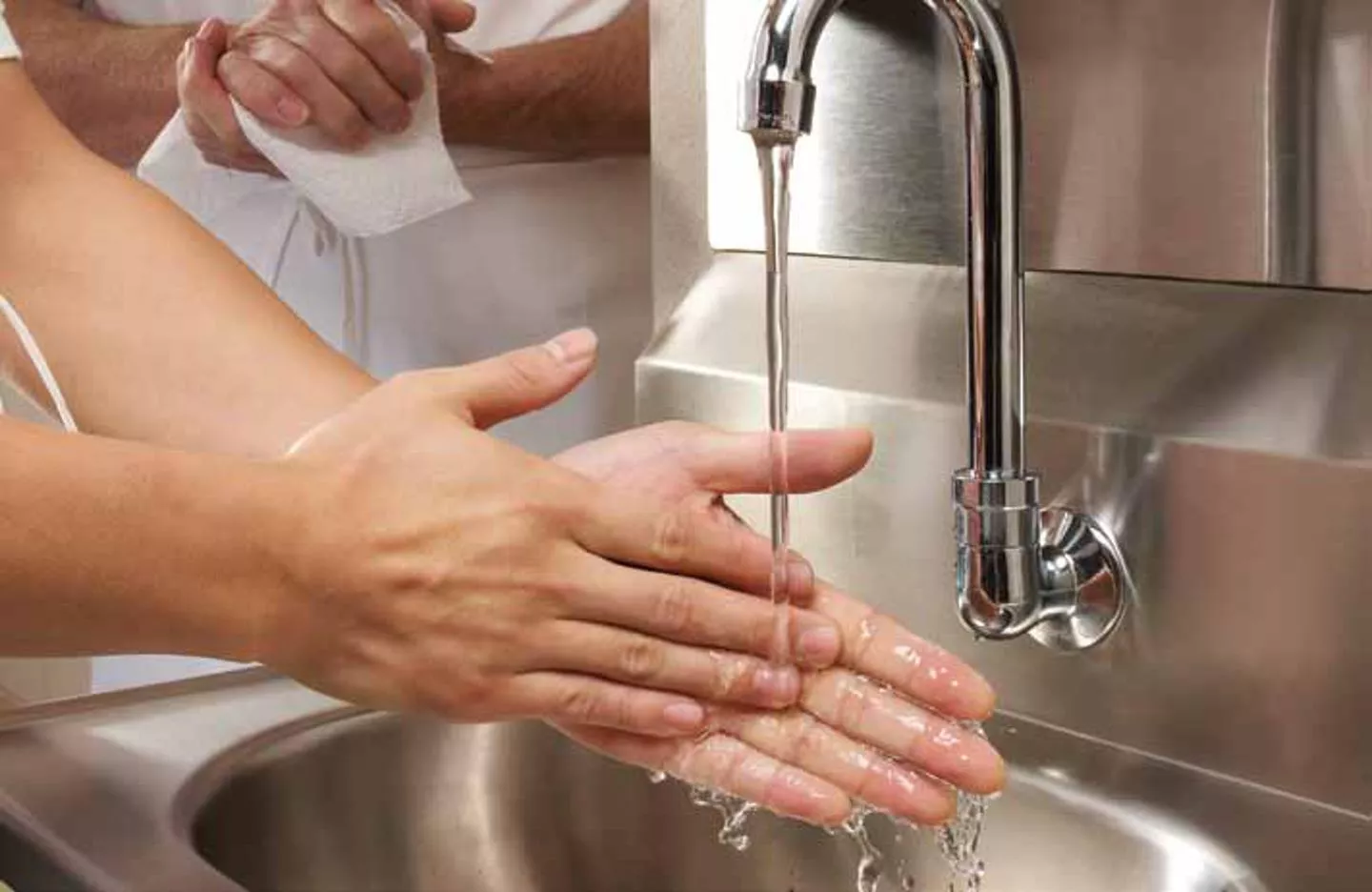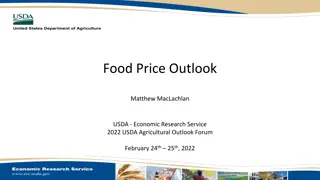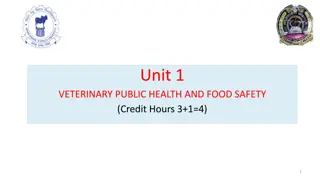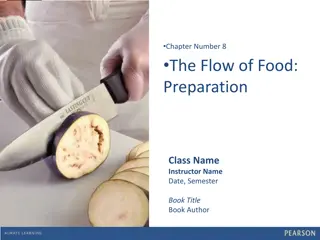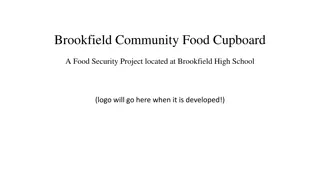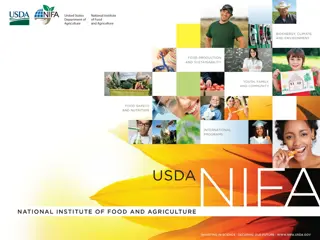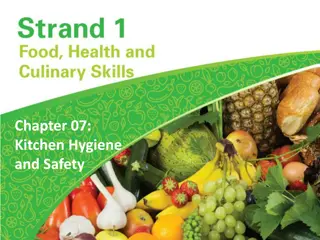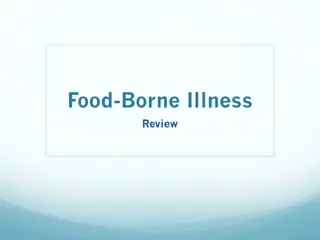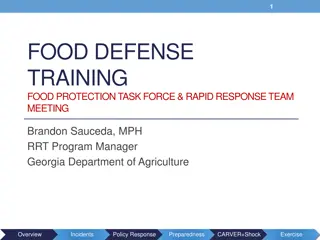The Safe Food Handler Training Program
This program focuses on essential food safety practices for food handlers, covering topics such as hand hygiene, use of gloves, proper attire, illness reporting, and more. Participants will learn how to prevent food contamination, maintain personal hygiene, and comply with regulations to ensure safe food handling practices.
Download Presentation

Please find below an Image/Link to download the presentation.
The content on the website is provided AS IS for your information and personal use only. It may not be sold, licensed, or shared on other websites without obtaining consent from the author. Download presentation by click this link. If you encounter any issues during the download, it is possible that the publisher has removed the file from their server.
E N D
Presentation Transcript
Chapter Number 4 The Safe Food Handler Class Name Instructor Name Date, Semester Book Title Book Author 1
Learning Objectives After this presentation, you should be able to complete the following Learning Outcomes 4.0 How food handlers can contaminate food 4.1 4.2 Correct handwashing procedure When and where hands should be washed 4.3 Hand antiseptics and when to use them 4.4 Hand-maintenance requirements 4.5 Correct way to cover infected wounds 4.6 The importance of avoiding bare-hand contact with ready-to-eat food 4.7 2
Learning Objectives After this presentation, you should be able to complete the following Learning Outcomes 4.0 How to use single-use gloves and when to change them 4.8 Requirements for staff work attire 4.9 Jewelry that poses a hazard to food safety 4.10 Policies regarding eating, drinking, and smoking 4.11 Criteria for excluding staff from the operation 4.12 Illnesses that need to be reported to the regulatory authority 4.13 3
4.0 KEY TERMS Carriers: People who carry pathogens and infect others, yet never get sick themselves. Hand antiseptics: Liquids or gels used to lower the number of microorganisms on the skin s surface. Hand antiseptics should only be used after correct handwashing, not in place of it. Only those hand antiseptics that arecompliant with the Food and DrugAdministration (FDA) should beused. Finger cots: Protective coverings used to cover a correctly bandagedcut or wound on the finger. Hair restraint: Device used to keep afood handler s hair away from foodand to keep the individual fromtouching it.
4.1 How food handlers can Contaminate food PERSONAL HYGIENE AND CONTAMINATION As a manager, you can minimize the risk of foodborne illness by carrying out the following responsibilities: Establishing specific personal hygiene policies Training food handlers on those policies and retraining them regularly Modeling correct behavior for food handlers at all times Supervising food safety practices at all times Revising policies according to changes in law and food safety science It is important for staff to not only have the correct knowledge, skills, and attitudes toward personal hygiene; but also to know how they can contaminate food if they are not careful. 5
4.1 How food handlers can Contaminate food PERSONAL HYGIENE AND CONTAMINATION Food handlers can contaminate food when they have any of the following: A foodborne illness Symptoms, such as diarrhea, vomiting, or jaundice (a yellowing of the eyes or skin) Wounds that contain a pathogen Sneezing or coughing Contact with a person who is sick Unwashed hands after touching a contaminant 6
4.1 How food handlers can Contaminate food CARRIERS Some people also carry pathogens and infect others without getting sick themselves. These people are called carriers. The bacteria Staphylococcus aureus is carried in the nose of 30 to 50 percent of healthy adults. About 20 to 35 percent of healthy adults carry it on their skin as well. Food handlers transfer this bacteria to food when they touch the infected areas of their bodies and then touch food 7
4.1 How food handlers can Contaminate food DISEASES NOT TRANSMITTED THROUGH FOOD In recent years, the public has expressed growing concern over communicable diseases spread through intimate contact or by direct exchange of bodily fluids. Diseases such as: Acquired Immune Deficiency Syndrome (AIDS) Hepatitis B and C Tuberculosis As a manager, you should be aware of the following laws concerning staff who have tested positive for the Human Immunodeficiency Virus (HIV) or who have tuberculosis or hepatitis B or C: The Americans with Disabilities Act (ADA) provides civil-rights protection to those who are HIV-positive or who have hepatitis B. This prohibits employers from firing people or transferring them out of food-handling duties simply because they have these diseases. Employers should maintain the confidentiality of any staff who have an illness that is not foodborne. 8
4.2 Correct Handwashing Procedure HOT TO WASH HANDS Wet hands and arms. Use running water as hot as you can comfortably stand. It should be at least 100 F (38 C). Apply soap. Apply enough to build up a good lather. Scrub hands and arms vigorously. Scrub them for 10 to 15 seconds. Clean under fingernails and between fingers. 9
4.2 Correct Handwashing Procedure HOW TO WASH HANDS (cont.) Rinse hands and arms thoroughly. Use running warm water. Dry hands and arms. Use a single-use paper towel or a hand dryer. Consider using a paper towel to turn off the faucet and to open the door when leaving the restroom. 10
4.3 When and Where Hands Should be Washed WHERE TO WASH HANDS Hands need to be washed in a sink designated for handwashing. Do not wash hands in sinks for: food prep dishwashing utility services 11
4.3 When and Where Hands Should be Washed WHEN TO WASH HANDS Food handlers must wash their hands before they start work. They must also do it after the following activities: Using the restroom Handling raw meat, poultry, and seafood (before and after) Touching the hair, face, or body Sneezing, coughing, or using a tissue 12
4.3 When and Where Hands Should be Washed WHEN TO WASH HANDS (cont.) After the following activities: Eating, drinking, smoking, or chewing gum or tobacco Handling chemicals that might affect food safety Taking out garbage Clearing tables or busing dirty dishes Touching clothing or aprons 13
4.3 When and Where Hands Should be Washed WHEN TO WASH HANDS (cont.) After the following activities: Handling money Leaving and returning to the kitchen/prep area Handling service animals or aquatic animals Touching anything else that may contaminate hands, such as dirty equipment, work surfaces, or wiping cloths 14
4.4 Hand Antiseptics and When to Use Them HAND ANTISEPTICS Liquids or gels that help lower the number of pathogens on skin If used, they must comply with the Code of Federal Regulations (CFR) and Food and Drug Administration (FDA) standards. Hand antiseptics must only be used after handwashing and not in place of it. Once an antiseptic is applied, food handlers should not touch food or equipment until the substance has dried. 15
4.5 Hand-maintenance Requirements HAND CARE In addition to washing, hands need other care to prevent the spread of pathogens. Make sure food handlers follow these guidelines: Fingernail length Keep fingernails short and clean. Fingernails should be trimmed and filed. False fingernails Do not wear false fingernails as they are hard to keep clean and can also break off into food. Some regulatory authorities allow False nails are allowed if single-use gloves are worn. Nail polish Do not wear nail polish as it can disguise dirt under nails. It may also flake off into food. Some regulatory authorities allow nail polish if single-use gloves are worn. 16
4.6 Correct Way to Cover Infected Wounds INFECTED WOUNDS OR CUTS Infected wounds, cuts, or boils contain pus. They must be covered to prevent pathogens from contaminating food and food-contact surfaces. How a wound is covered depends on where it is located: Cover wounds on the hand or wrist with an impermeable cover. Cover wounds on the arm with an impermeable cover, such as a bandage. The wound must be completely covered. Cover wounds on other parts of the body with a dry, durable, tight-fitting bandage. 17
The importance of avoiding bare-hand contact with ready-to-eat food 4.7 BARE-HAND CONTACT WITH READY-TO-EAT FOOD Food can become contaminated when it has been handled with bare hands. Do not handle ready-to-eat food with bare hands. Some regulatory authorities allow bare-hand contact with ready-to-eat food. If your jurisdiction allows this, you should have specific policies in place about staff health. You should also train staff in handwashing and personal hygiene practices. Check your local regulatory requirements.
4.8 How to Use Single-Use Gloves and When to Change Them SINGLE-USE GLOVES Single-use gloves can help keep food safe by creating a barrier between hands and food. They should be used when handling ready-to-eat food. Gloves do not need to be worn when washing produce. Gloves do not need to be worn when handling ready- to-eat ingredients for a dish that will be cooked to the correct internal temperature, such as a pizza. Gloves can never be used in place of handwashing. Hands must be washed before putting on gloves and when changing to a new pair. 19
4.8 How to Use Single-Use Gloves and When to Change Them HOW TO USE GLOVES If you are not careful when using gloves, the food you handle can become unsafe. Follow these guidelines: Wash and dry your hands before putting on gloves. Choose the correct glove size. Hold gloves by the edge when putting them on. Avoid touching the glove as much as possible. Once you have put them on, check the gloves for rips or tears. Do not blow into gloves. Do not roll gloves to make them easier to put on. 20
4.8 How to Use Single-Use Gloves and When to Change Them WHEN TO CHANGE GLOVES Food handlers must change gloves at these times: As soon as the gloves become dirty or torn Before beginning a different task After an interruption, such as taking a phone call After handling raw meat, seafood, or poultry and before handling ready-to-eat food 21
4.9 Requirements for Staff Work Attire CORRECT WORK ATTIRE Food handlers in dirty clothes may give a bad impression of your operation. Dirty clothing may carry pathogens that can make people sick. Set up a dress code and make sure staff follow. The code should include the following guidelines: 22
4.9 Requirements for Staff Work Attire CORRECT WORK ATTIRE (cont.) Hair restraints Wear a clean hat or other hair restraint when in a prep area. A hair restraint will keep hair away from food and keep the food handler from touching it. Do not wear hair accessories that could become physical contaminants. Hair accessories should be limited to items that keep hands out of hair and hair out of food. False eyelashes can likewise become physical contaminants and should not be worn. Food handlers with facial hair should also wear a beard restraint. 23
4.9 Requirements for Staff Work Attire CORRECT WORK ATTIRE (cont.) Clean clothing Wear clean clothing daily. If possible, change into work clothes at work. Dirty clothing that is stored in the operation must be kept away from food and prep areas. Aprons Remove aprons when leaving prep areas. For example, aprons should be removed and stored before taking out garbage or using the restroom. Never wipe your hands on your apron. 24
4.10 Jewelry That Poses a Hazard to Food Safety JEWELRY Remove jewelry from hands and arms before prepping food or when working around prep areas. These items can fall off and become a physical contaminant. Do not wear any of the following: Rings, except for a plain band. Bracelets, including medical bracelets. Watches. Your company may also require you to remove other jewelry. Servers may wear jewelry if allowed by company policy. Check with your regulatory authority regarding jewelry requirements. Requirements should be included in written policies that are both monitored and enforced. 25
4.11 Policies Regarding Eating, Drinking, and Smoking EATING, DRINKING, SMOKING, AND CHEWING GUM OR TOBACCO Small droplets of saliva can contain thousands of pathogens. Eating, drinking, smoking, or chewing gum or tobacco can transfer saliva to hands or directly to food being handled. Do not eat, drink, smoke, or chew gum or tobacco when doing any of the following: Prepping or serving food Working in prep areas Working in areas used to clean utensils and equipment 26
4.11 Policies Regarding Eating, Drinking, and Smoking EATING, DRINKING, SMOKING, AND CHEWING GUM OR TOBACCO (cont.) Only eat, drink, smoke, and chew gum or tobacco in designated areas. Some regulatory authorities allow food handlers to drink from a covered container while in these areas. Check your local regulatory requirements to be sure. If food must be tasted during prepping, it should be placed in a separate dish and tasted with a clean utensil. The dish and utensil should then be removed from the prep area or discarded. 27
Criteria for Excluding Staff from the Operation or Restricting Them from Working 4.12 WHEN TO RESTRICT STAFF FROM WORKING AROUND FOOD When food handlers are sick, you may need to restrict them from working with or around food. You might also need to exclude them from working in the operation. Work with your local regulatory authority to determine how to respond. Use the chart on the page xxx to help you decide how to handle staff illnesses. 28
Criteria for Excluding Staff from the Operation or Restricting Them from Working 4.12 WHEN TO RESTRICT STAFF FROM WORKING AROUND FOOD (cont.) 29
Illnesses that Need to be Reported to the Regulatory Authority 4.13 REPORTING HEALTH ISSUES Require staff to let you know when they are sick. Your regulatory authority may ask for proof that you have done this. You can provide it in the following ways: Presenting signed statements in which staff have agreed to report illness Providing documentation showing staff have completed training, which includes information on the importance of reporting illness Posting signs or providing pocket cards that remind staff to notify managers when they are sick 30






